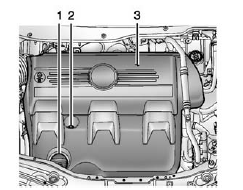Chevrolet Captiva Owners Manual: Engine Cover

Engine Cover (3.0L V6)
- Oil Fill Cap
- Engine Cover Bolt
- Engine Cover
To remove:
- Remove the oil fill cap (1).
- Remove the engine cover bolt (2).
- Raise the engine cover (3) to release it from the retainers.
- Lift and remove the engine cover.
- Reverse Steps 1-4 to reinstall the engine cover.
Engine cover in a Chevrolet Captiva (C100, C140) plays a crucial role in protecting the engine components and enhancing the overall appearance of the engine bay. It is typically made of durable plastic or composite material and is designed to fit snugly over the engine to shield it from dirt, debris, and moisture.
One of the primary functions of the engine cover is to help maintain a clean engine compartment. By covering the engine, it prevents dust, leaves, and other contaminants from entering and accumulating on vital engine parts. This helps in prolonging the life of engine components and ensures optimal performance.
Additionally, the engine cover contributes to noise reduction within the engine bay. It helps in dampening engine noise and vibrations, resulting in a quieter and more comfortable driving experience for passengers.
The design of the engine cover often includes integrated insulation materials or sound-deadening features, further enhancing its noise-reducing properties. This is especially beneficial for vehicles with powerful engines or diesel engines known for their louder operation.
In terms of aesthetics, the engine cover adds a sleek and finished look to the engine bay. It conceals unsightly engine components and wiring, giving the engine compartment a tidy and professional appearance.
Maintaining the engine cover involves periodic cleaning to remove dirt and grime buildup. Use a mild detergent and water to clean the cover, and avoid using harsh chemicals or abrasive materials that may damage the surface.
Engine cover in the 2014 Chevrolet Captiva serves multiple purposes, including protection, noise reduction, and aesthetic enhancement. Its durable construction and functional design contribute to the vehicle's overall performance and visual appeal.
 Engine Compartment Overview
Engine Compartment Overview
2.4L L4 Engine
Engine Air Cleaner/Filter on
page 10-12.
Power Steering Fluid Reservoir.
See Power Steering Fluid on
page 10-20.
Engine Cooling Fan (Out of
View). See Cooling System ...
 Engine Oil
Engine Oil
To ensure proper engine
performance and long life, careful
attention must be paid to engine oil.
Following these simple, but
important steps will help protect
your investment:
Always use en ...
More about:
Chevrolet Captiva Owners Manual > Vehicle Checks: Brakes
This vehicle has disc brakes. Disc
brake pads have built-in wear
indicators that make a high-pitched
warning sound when the brake pads
are worn and new pads are needed.
The sound can come and go or be
heard all the time when the vehicle
is moving, except when applying the
brake pedal firml ...
Chevrolet Captiva Owners Manual
- Introduction
- In Brief
- Keys, Doors, and Windows
- Seats and Restraints
- Storage
- Instruments and Controls
- Lighting
- Infotainment System
- Climate Controls
- Driving and Operating
- Vehicle Care
- Service and Maintenance
- Technical Data
- OnStar
